2009 Corn Production Increases from Last Month
US feed grain supplies for 2009/10 are increased this month with higher forecast corn and sorghum production, reflecting favorable growing conditions for corn across the western Corn Belt and the northern half of the Great Plains. Corn yields are expected to reach a new record. Corn feed and residual use is increased with the larger crop. US corn exports were raised because of increased import demand and reduced competition, especially from South America. With larger feed grain production, all 2009/10 feed grain prices are projected lower.

Record Feed Grain Supply and Use
US feed grain production in 2009/10 is forecast at 344.8 million metric tons, up 5.2 million from a month ago and up 18.9 million from 2008/09. Corn and sorghum production are both up from last month. Forecast beginning stocks are down 900,000 tons from last month but up 2.1 million from last year. Feed grain supplies in 2009/10 are forecast at a record 394.6 million tons, up 4.2 million from last month and up 20.7 million from last year due to a record forecast corn yield.
Total feed grain use in 2009/10 is up 3.8 million tons this month to a record 349 million. Total use is up 22.3 million tons from 2008/09. Higher feed and residual use and exports account for the month-to-month increase in total use. Feed grain use in food, seed, and industrial use (FSI) remains unchanged this month for 2009/10.
When converted to a September-August marketing year, feed and residual use for the four feed grains plus wheat in 2009/10 is projected to total 148.02 million tons, up 1.27 million from last month and up 1.33 million from 2008/09. This is based on higher projections for corn feed and residual use in 2009/10. Corn is estimated to account for 92 per cent of the feed and residual use in 2009/10, up from 91 per cent in 2008/09.
The projected index of grain-consuming animal units (GCAU) for 2009/10 is forecast at 91.08 million units, up 0.52 million this month but down 1.7 million from 2008/09. The grain used per GCAU in 2009/10 is expected to be 1.63 tons, up from 1.62 tons last month and 1.58 tons in 2008/09.
Total US meat production for 2009 is raised as higher pork and broiler production more than offset lower beef production. Pork production is raised due to higher third-quarter slaughter at significantly higher weights due to favorable summer weather. Lower corn prices are expected to encourage increased weights through the fall. The broiler production forecast is also raised based on higher third-quarter slaughter. The beef production forecast is reduced on lower expected cow slaughter. Turkey production is unchanged. Meat production forecasts for 2010 are raised from last month. Higher feedlot placements in late 2009 and early 2010 result in higher beef production while lower prices for corn will support increased broiler meat production and slightly higher hog weights.
Record Corn Yield Forecast
Corn production in 2009 is forecast at 12.954 billion bushels, up 193 million bushels from last month and 853 million bushels above 2008. Based on 1 September conditions, the average corn yield is forecast at a record 161.9 bushels per acre, compared with 159.5 bushels per acre last month and actual 2008 yield of 153.9 bushels per acre. The 1 September corn objective yield data indicate a record high number of stalks and ears per acre for the combined 10 objective yield States (Illinois, Indiana, Iowa, Kansas, Minnesota, Missouri, Nebraska, Ohio, South Dakota and Wisconsin). All objective yield States, except Missouri and Wisconsin, recorded record high ear counts. Beginning stocks were lowered 25 million bushels this month to 1.695 billion. Imports for 2009/10 are projected to be down five million bushels this month to 10 million due to a smaller expected corn crop in Canada.
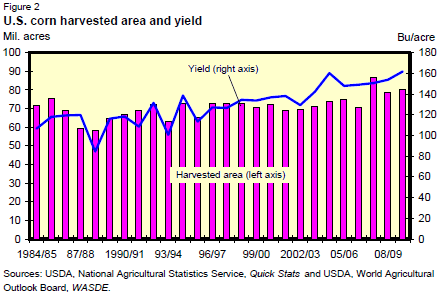
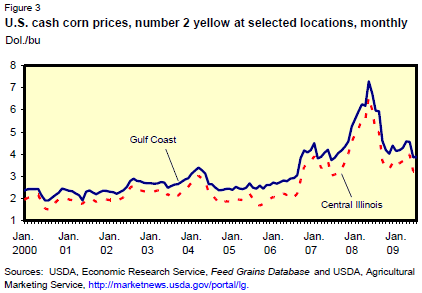
Forecast 2009/10 corn use was increased 150 million bushel from last month to a record 13.025, billion, up 980 million from expected use in 2008/09. Exports were increased 100 million bushels to 2.2 billion as a result of reduced foreign supplies and lower US prices for corn. Feed and residual use of corn was raised 50 million bushels to 5.35 billion because of higher yields, which are associated with increased feed and residual use. FSI use of corn remains unchanged at 5.475 billion bushels for 2009/10.
Projected corn ending stocks for 2008/09 are lowered 25 million bushels from last month to 1.695 billion, FSI use is raised 25 million bushels to 4.945 billion. This increase is in corn used for ethanol, based on record July and August production of gasoline blends with ethanol as reported by the Energy Information Administration.
Reflecting increasing supplies, the forecast corn price for 2009/10 is lowered 25 cents on the high end of the range, and lowered 5 cents on the low end of the range to $3.05-$3.65 per bushel. In 2008/09, the season average price received by farmers is expected to be $4.08 per bushel.
Sorghum Production Prospects Up
Sorghum production is forecast at 390 million bushels for 2009/10, up nine million bushels this month. Sorghum plantings and area to be harvested for grain for 2009/10 were unchanged this month but are down from last year. Based on 1 September conditions, sorghum yield is increased 1.5 bushels per acre this month to 65.5 bushels per acre. Kansas, the top producing State, experienced cooler than normal temperatures during August, and the yield forecast increased 3.0 bushels from last year. Producers in Texas, the second largest sorghum-producing State, expect a yield of 47 bushels per acre, unchanged from last month but down 5 bushels from last year. The increase in production partially offsets the decline in beginning stocks, which are lowered 10 million bushels to 40 million. Sorghum use for 2009/10 remains unchanged this month. Ending stocks for 2009/10 are 50 million bushels, down one million from last month, reflecting changes in supplies.
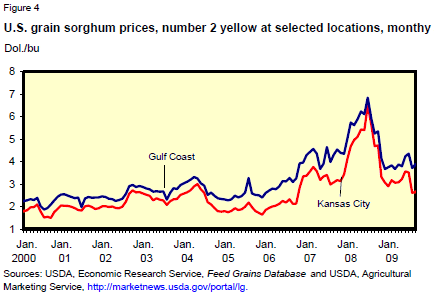
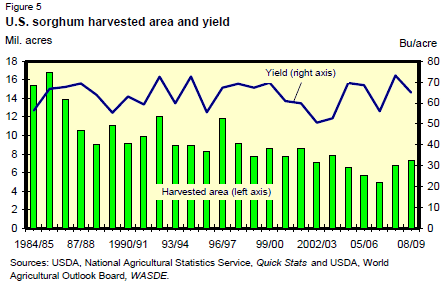
In 2008/09, sorghum exports are raised 10 million bushels this month to 145 million as foreign demand for sorghum remains strong, particularly in Mexico. This resulted in a 10-million-bushel drop in US ending stocks to 40 million bushels for 2008/09.
The forecasted season average price for 2008/09 is expected at $3.23 per bushel. For 2009/10 the projected sorghum price was lowered 10 cents on both ends of the range to $2.60-$3.20 per bushel, as larger corn supplies weaken feed grain prices.
Barley and Oats Supply Unchanged
Barley and oats production were not revised in the September Crop Production report. Any production revisions will be reported in the Small Grains 2009 Summary to be released on 30 September 2009. No changes were made this month in barley or oats supply or use. For the 2008/09 marketing year, season average prices for barley and oats remain unchanged. The 2009/10 projected barley price was lowered 10 cents on each end of the forecast range to $3.60 to 4.30 per bushel. The 2009/10 projected oats price was lowered 30 cents on the high end of the range and 10 cents on the low end of the range to $1.80 to 2.20 per bushel. This is a result of larger corn supplies and weaker corn prices expected for 2009/10.
Foreign Corn Production Decline More than Offsets US Increase
World coarse grain production in 2009/10 is projected down 1.54 million tons this month to 1,090.0 million. Corn production shifted dramatically with increased US production offset by reduced prospects in foreign countries. Oats prospects increased 0.5 million tons to 23.7 million because of a 0.3-million-ton increase for Canada and smaller increases for Belarus and the EU. Global barley production is projected up slightly this month to 142.9 million tons as a 0.5-million-ton increase for Ukraine and smaller increases for the EU, Canada, and Belarus were mostly offset by a 1.0-million-ton decline for Russia, where harvest yields in the Volga Valley slumped. World sorghum production is projected slightly lower this month as dryness in Mexico has trimmed crop prospects. Global rye, millet, and mixed grain production prospects are nearly unchanged this month.
China’s corn production prospects for 2009/10 are reduced 2.5 million tons this month to 160.0 million. Drought has hurt corn production prospects across parts of Manchuria, including the leading corn provinces of Jilin and Liaoning. However, exceptionally good growing conditions in other regions are partly offsetting.
Brazil’s corn production prospects are cut 2.0 million tons this month to 52 million. The strong price of soybeans, compared with corn, is expected to encourage a shift from corn to soybean planted area in the south, especially in Parana. Soybeans have lower production costs and are less risky than corn, which is increasingly important because the strong Brazilian currency is squeezing farmer’s profit margins. The planting period for the main-season corn crop in the south is just beginning, and the recent shift in price incentives is likely to be crucial.
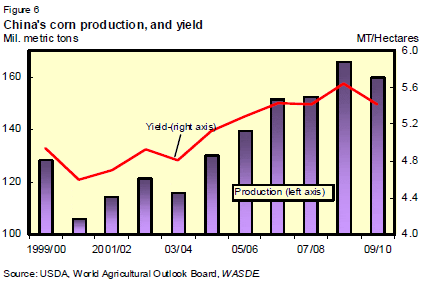
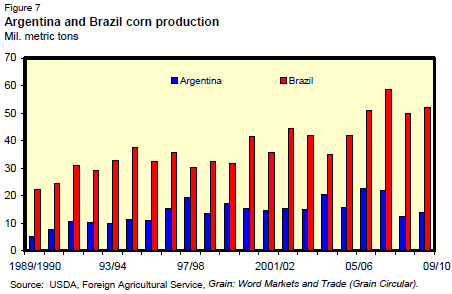
Argentina’s corn production is forecast down 1.0 million tons to 14.0 million. Relative prices and government policy are pushing producers to plant more soybeans instead of corn.
Canada’s corn crop is reduced 0.9 million tons this month to 9.4 million as surveys by Statistics Canada indicated that a cool growing season has reduced expected yields.
Kenya’s corn production is slashed 0.9 million tons to 1.8 million as a second year of drought has cut yield prospects and trimmed area.
EU corn production is down 0.3 million tons this month as reduced area in France and poor yield prospects in Italy more than offset increased production expected in Romania and Greece.
Serbia’s corn production prospects increased 0.4 million tons to 6.4 million as growing conditions have been mostly favorable.
Global 2009/10 Coarse Grain Supplies Unchanged This Month
month, leaving supplies virtually unchanged. Global beginning stocks are up 1.56 million tons, with a 2.5-million-ton increase in foreign stocks more than offsetting the reduction in US stocks. Brazil’s corn and sorghum 2009/10 beginning stocks are raised 1.2 million tons this month as trade data indicate lower-than-previouslyforecast exports in local marketing year 2008/09. Reduced EU corn exports for 2008/09 are also contributing to a 0.8-million-ton increase in 2009/10 beginning stocks. Statistics Canada published grain stocks data that indicated higher stocks and less feed and residual use of barley, oats, and rye in 2008/09. These more than offset reduced corn stocks, raising coarse grain stocks 1.0 million tons this month. Argentina, Belarus, and some other countries had small reductions in 2009/10 beginning stocks this month.
Increased Use Trims Projected 2009/10 Ending Stocks
With 2009/10 coarse grain supplies projected virtually unchanged this month, a forecast increase in feed and residual use results in lower ending stocks. Global total use is forecast up 2.4 million tons this month to 1,099.3 million. Foreign use is up 1.2 million tons, about the same as the US increase. Coarse grain feed use in the EU is forecast up 1.6 million tons this month to 112.4 million tons. Projected barley feed use is up 1.5 million tons this month to 43.5 million due to increased supplies and the expectation that prices would remain high enough to limit entry into intervention stocks. There were small increases in projected 2009/10 feed use for Canada, Ukraine, Belarus, Brazil, Mexico, and other countries, but Argentina and Serbia each had projected feed use cut 0.3 million tons as the share of corn being exported limits the amount available for domestic use.
World coarse grain ending stocks for 2009/10 are forecast down 2.4 million tons this month to 179.1 million. The small US increase is more than offset by tighter foreign stocks. The largest change this month is for China, down 2.5 million tons to 55.7 million due to reduced corn production prospects. However, projected coarse grain ending stocks are still slightly higher than 2009/10 beginning stocks. Russia’s forecast ending stocks are down 1.3 million tons to 2.0 million, mostly because of reduced barley production prospects. Reduced expectations for Brazil’s corn production is trimming coarse grain ending stocks 0.9 million tons to 10.1 million. Countries with small reductions in projected coarse grain ending stocks include Turkey, Mexico, Argentina, Jordan and Kenya.
Canada’s coarse grain ending stocks are projected 1.4 million tons higher this month due to increased beginning stocks and stronger import prospects. Smaller increases are forecast for Serbia, the EU, Ukraine, Kazakhstan, Belarus, and Uruguay.
Increased Demand, Reduced Competition Boost US Corn Exports Prospects
World corn trade is forecast 1.9 million tons higher this month to 86.3 million. Imports by Canada are projected up 1.1 million tons this month to 3.5 million. Even with reduced meat production forecast for 2010, Canada is expected to increase corn imports due to a year-to-year decline in coarse grain and wheat production. Kenya’s corn imports are projected up 0.9 million tons this month to 1.0 million as a second year of drought makes large imports necessary.
Argentina’s corn exports are projected down 1.0 million tons to 7.0 million, the lowest in 14 years, due to reduced production prospects. Prices, weather, and government policies are encouraging an area shift from corn to soybeans. Prospects for EU corn exports are trimmed 0.5 million tons this month to 1.5 million as prices for EU corn from Romania, Bulgaria, and Hungary are not competitive with Ukrainian or US corn.
The combination of increased world corn trade and reduced competition boost prospects for US October-September 2009/10 corn exports 3.0 million tons this month to 56.0 million. As of 3 September 2009, outstanding export sales of corn reached 12.1 million tons, up from 11.9 a year earlier.
Changes to projected 2009/10 trade for other coarse grains are small, with a small increase in Argentina’s sorghum exports and rye from Belarus.
As 2008/09 October-September trade is in its final month, trade data are far from complete, but enough are available to support several shifts in forecast trade. US corn exports are increased 0.5 million tons this month to 47.5 million. October 2008 to July 2009 Census exports reached 38.1 million tons. Grain export inspections in August 2009 were large at 4.5 million tons, and shipments in September are expected to continue to be large, supporting the increased forecast.
World corn trade for 2008/09 was reduced slightly this month as the US increase was more than offset by other changes. Brazil’s corn exports are cut 1.0 million tons to 7.5 million as internal corn prices have not been competitive on the world market, slowing the pace of exports. EU corn exports are trimmed 0.25 million tons to 1.75 million as the pace of export licenses has been slower than expected. However, Serbia has shipped corn aggressively to the EU, boosting its export prospects 0.3 million tons to 1.3 million. Corn imports for 2008/09 are raised 0.3 million tons this month for Kenya and 0.25 million for Turkey.
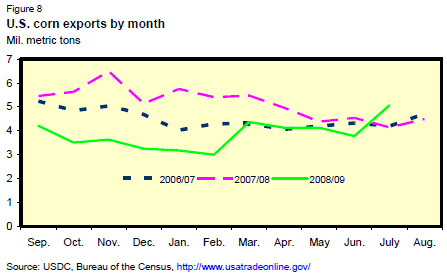
Further Reading
| - | You can view the full report by clicking here. |
September 2009


